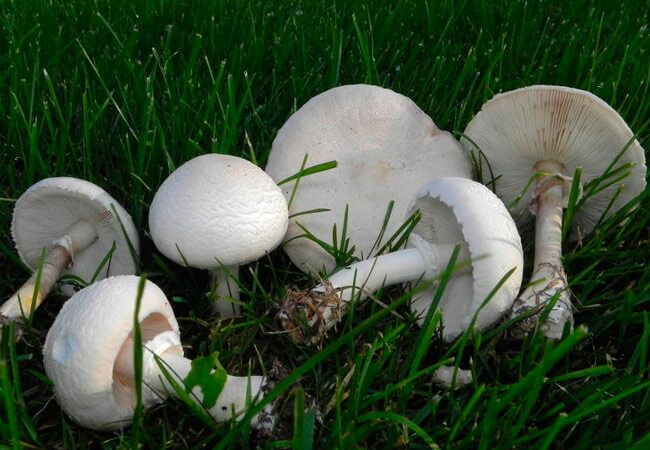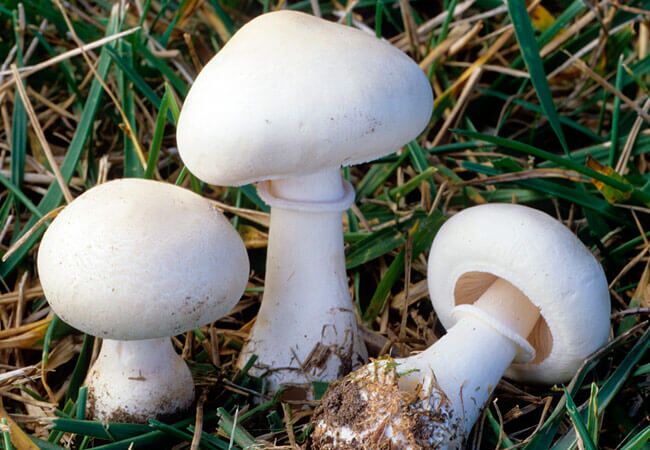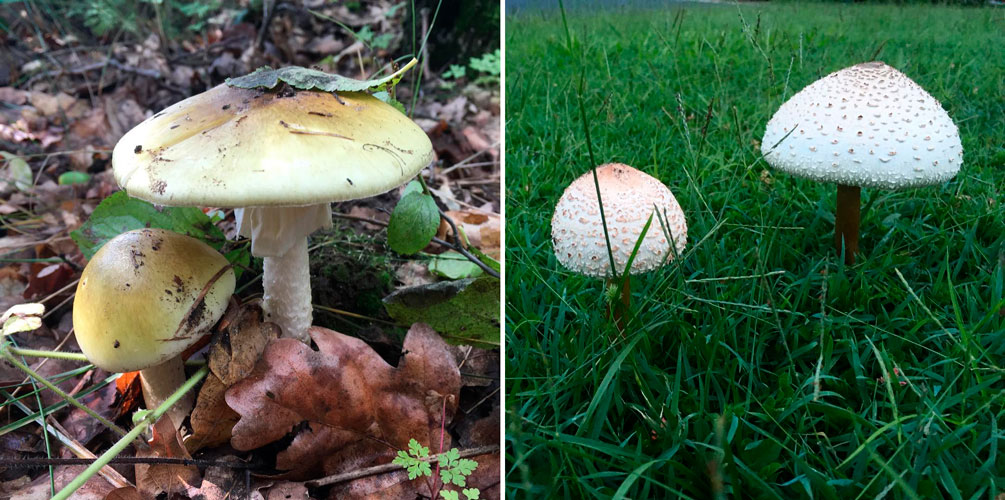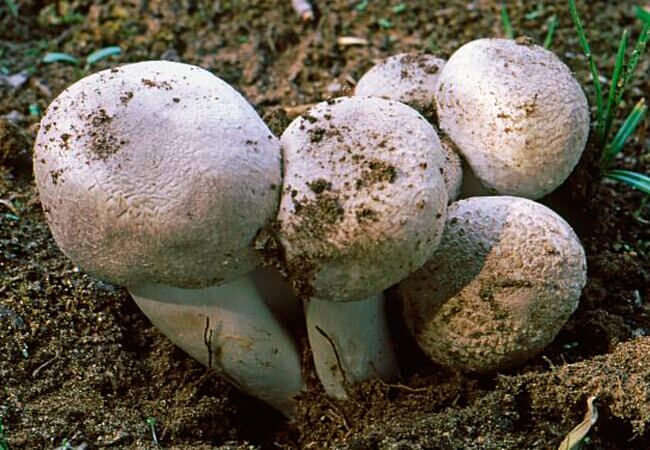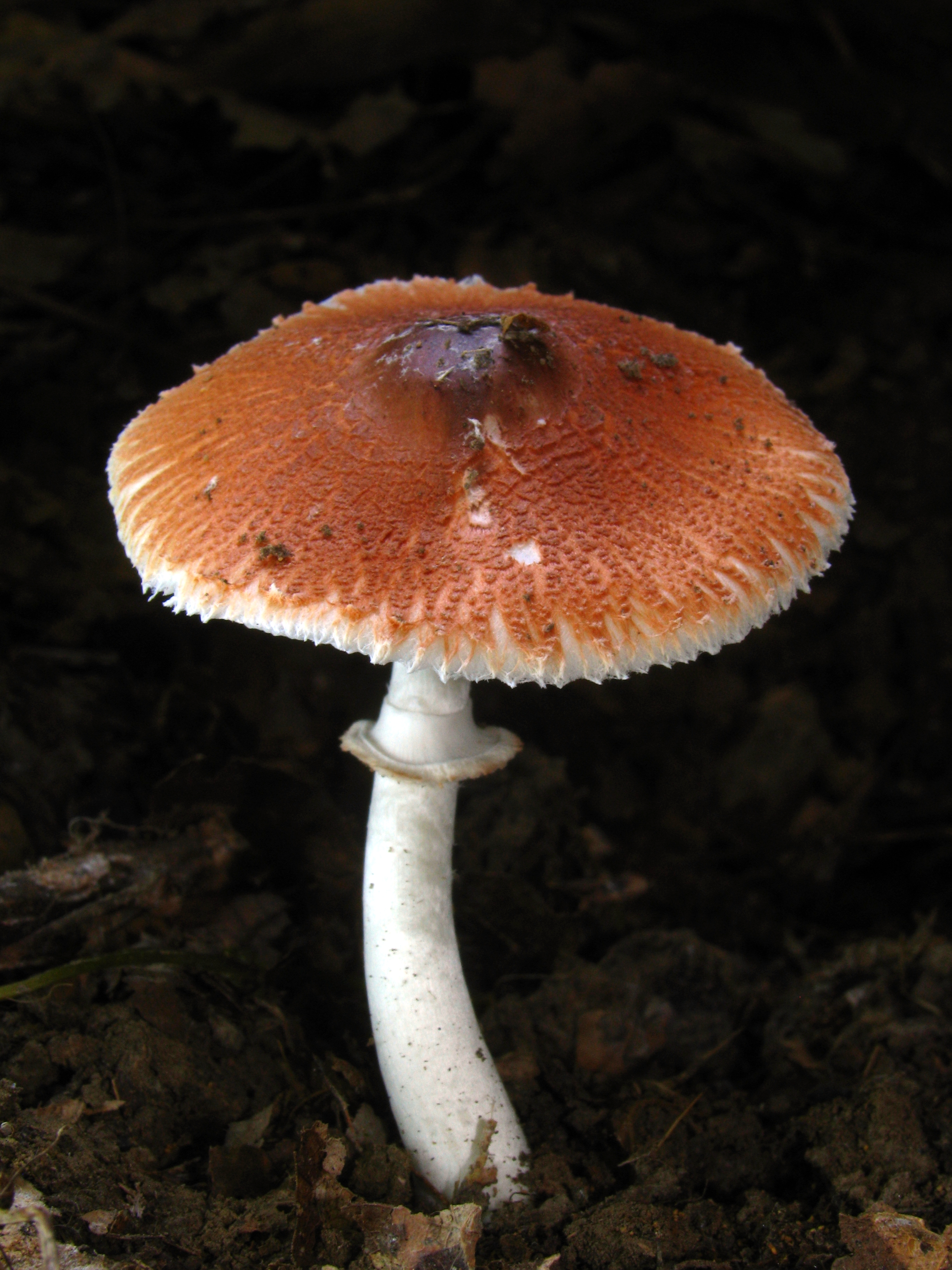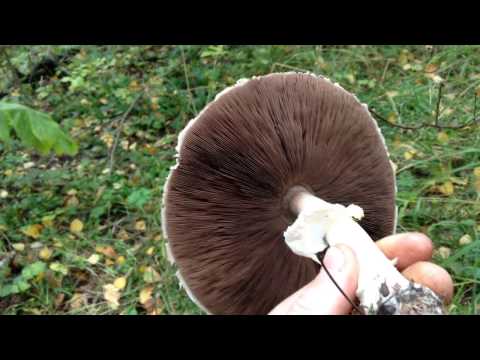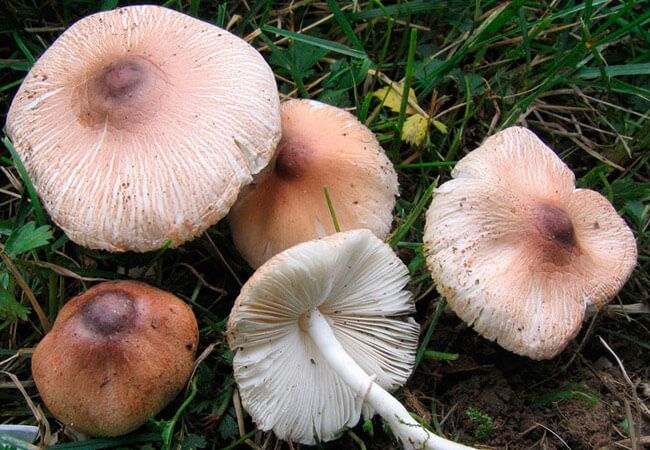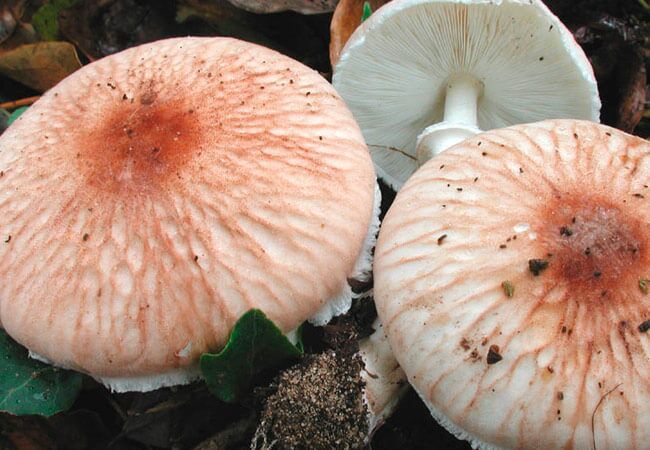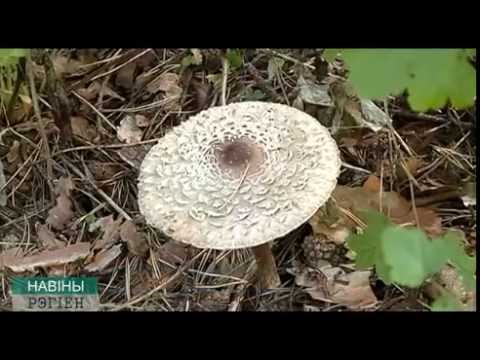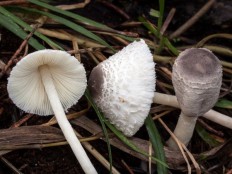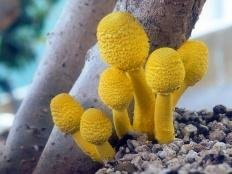BELO PUTINNIKI, BELO CHAMPIGNONS, BELONAVOZNIKI
There is a group of species that, in a number of ways, are similar to champignons, or dung beetles, or cobwebs. However, they also differ from these mushrooms. These species belong to the genera Belochampignon, Belo-dung beetle and Belopautinnik.
Fruit bodies of white-webbed (genus Leucocortinarius) in habit are similar to the fruiting bodies of some species of spiderwebs (genus Cortinarius) and differ from them only by colorless smooth spores and whitish spore powder. Therefore, most authors consider them within the framework of the Webinnikov family (Cortinariaceae)‘.Year White-webbed monotypic, represented by one species, known both in Ukraine and in Crimea, and being a symbiotroph (mycorrhiza-forming) according to its ecological status.
Belonavozniki (genus Leucocoprinus) and Belochampignons (genus Leucoagaricus) were separated from the Lepiota clan (Lepiota) and belong to the Agaric or Champignon family (Agaricaceae).
Species of the genus Leucoagaricus differ from species of the genus Agaricus mainly the habitus of fruiting bodies, colorless spores with occasional germination and white or whitish spore powder. This genus has 26 species, 14 are known in Europe, 4 in Ukraine, and 2 in Crimea. Recently, the number of the genus Leucoagaricus increases due to the inclusion of some species from the genera Macrolepiota and Lepiota, for example, such as a mushroom umbrella girlish see the section "Mushrooms-umbrellas"), and the lepiot of Vikhansky (Lepiota wichanskyi, see this section). According to the ecological status, the species of this genus are humic saprotrophs.
In species of the genus Leucocoprinus fruiting bodies resemble some species of dung beetles (genus Coprinus), but they differ from them in plates not blackening and not spreading with age, colorless spores and whitish, creamy or yellowish spore powder. The genus Belonavoznik has about 20 species that grow naturally, mainly in the Southern Hemisphere. In the temperate zone of the northern hemisphere, a number of species of this genus are found spontaneously in greenhouses, hotbeds, greenhouses, often in plantings of tropical and subtropical plants. In Ukraine, 7 species of Belonavoznik are known, and 3 of them were found only in botanical gardens. One species - Bogush's whitewash (Leucocoprinus bohusi S. Wasser) - is an endem of Ukraine, known from the Khomutovskaya Steppe reserve (botanical-geographical region Donetsk Zlakovo-Lugovaya Steppe). In Crimea, 2 species are known to date. According to the ecological status, the species of this genus are humic saprotrophs. They grow on humus-rich soil in greenhouses, greenhouses, greenhouses, in natural conditions on heaps of garbage, compost, sawdust, in yards, parks, gardens, some grow on soil in broad-leaved, coniferous and mixed plantations.
Photo: V. Cetto. I funghi dal vero, Vol. 1.
Views
List on the site "Encyclopedia of Life" and other sources:
- Leucoagaricus amanitoides R.M. Davis & Vellinga, 2006
- Leucoagaricus americanus (Peck) Vellinga, 2000
- Leucoagaricus barssii (Zeller) Vellinga, 2000
- Leucoagaricus brunneocingulatus (P.D. Orton) Bon, 1976
- Leucoagaricus carneifolius (Gillet) Wasser, 1977 - Body-lamellar white champignon
- Leucoagaricus cinerascens (Quél.) Bon & Boiffard, 1978 - Belochampignon gray, or smoky
- Leucoagaricus croceovelutinus Bon, 1976
- Leucoagaricus crystallifer Vellinga, 2000
- Leucoagaricus crystalliferoides T.K.A. Kumar & Manim., 2009
- Leucoagaricus dacrytus Vellinga, 2010
- Leucoagaricus georginae (W.G. Sm.) Candusso, 1990
- Leucoagaricus glabridiscus (Sundb.) Wuilb., 1986
- Leucoagaricus gongylophorus (Möller) Singer, 1986
- Leucoagaricus griseodiscus (Bon) Bon & Migl., 1991
- Leucoagaricus ionidicolor Bellù & Lanzoni, 1988
- Leucoagaricus irinellus Chalange, 1999
- Leucoagaricus leucothites (Vittad.) Wasser, 1977 - Belochampignon ruddy, or nut umbrella
- Leucoagaricus marriagei (D.A. Reid) Bon, 1976
- Leucoagaricus medioflavoides Bon, 1976
- Leucoagaricus meleagris (Sowerby) Singer, 1952
- Leucoagaricus menieri (Sacc.) Singer, 1968
- Leucoagaricus moseri Wasser, 1978 - Moser Belochampignon
- Leucoagaricus nympharum (Kalchbr.) Bon, 1977
- Leucoagaricus pilatianus (Demoulin) Bon & Boiffard, 1976
- Leucoagaricus purpureolilacinus Huijsman, 1955
- Leucoagaricus serenus (Fr.) Bon & Boiffard, 1974
- Leucoagaricus sericifer (Locq.) Vellinga, 2000 - Silky white champignon
- Leucoagaricus subcretaceus Bon, 1981
- Leucoagaricus sublittoralis (Kühner ex Hora) Singer, 1969
- Leucoagaricus tener (P.D. Orton) Bon 1977
- Leucoagaricus viridiflavoides B.P. Akers & Angels, 2000
- Leucoagaricus wichanskyi (Pilát) Bon & Boiffard, 1974 - Vihansky Belochampignon
Species attributed by some authors to the genus Belochampignon and transferred to other genera:
- Leucoagaricus badhamii (Berk. & Broome) Singer, 1951 = Leucocoprinus badhamii (Berk. & Broome) M.M. Moser, 1943
- Leucoagaricus caldariorum (D.A. Reid) Bon, 1993 = Leucocoprinus caldariorum D.A. Reid, 1990
- Leucoagaricus cretaceus (Bull.) M.M. Moser, 1953 = Leucocoprinus cretaceus (Bull.) Locq., 1945
- Leucoagaricus excoriatus (Schaeff.) Singer, 1948 = Macrolepiota excoriata (Schaeff.) M.M. Moser, 1978 - White umbrella mushroom
- Leucoagaricus hortensis (Murrill) Pegler, 1983 = Chlorophyllum hortense (Murrill) Vellinga, 2002
- Leucoagaricus josserandii (Bon & Boiffard) Raithelh., 1989 = Lepiota subincarnata J.E. Lange, 1940
- Leucoagaricus medioflavus (Boud.) Bon, 1976 = Leucocoprinus medioflavus (Boud.) Bon, 1976
- Leucoagaricus medullatus (Fr.) Bon, 1977 = Lepiota medullata (Fr.) Quél., 1872
- Leucoagaricus pulverulentus (Huijsman) Bon, 1978 = Cystolepiota pulverulenta (Huijsman) Vellinga, 1992
Description of the mushroom
Valuya's botanical name is Russula foetens. It belongs to the russula family, but many mushroom pickers do not want to take it into their basket. In numerous photos, you can see the specific external characteristics of the fruiting body, and a description of the taste of the mushroom and the place of its growth are listed below.
What does it look like
Valuy can be called differently - a sullion, a cowshed, a pig, a goby, a cam, a weeping mushroom. All of them arose due to the external specific characteristics inherent in this type of lamellar fungus.
Botanical description of Valui:
- The stem of the fruiting body is cylindrical. Its height is 5–15 cm, and its diameter is about 3.5 cm.
- The thickness of the massive cap is about 5 cm. In young specimens, it has the shape of a hemisphere, and with age it gradually flattens out and becomes like a saucer up to 14 cm in diameter. The edges of the cap of the mushroom adhere tightly to its stem.
- The lower part of the culb is colored light yellow. The hat is slippery, has a small notch in the center and has a light brown tint.
- On the lower surface of the apex of the mushroom, there are long cream or yellowish plates. They all the time emit a light liquid, leaving dark spots on the stem.
- The flesh is dense and brittle, white or creamy. From contact with air, the cut site quickly darkens.
Where it grows
Valui can be found in mixed and coniferous forest. In Russia, it is collected in the Caucasus, in the western part of Siberia, as well as in the Far East. Kulbiks are also common throughout North America and Eurasia. These mushrooms can grow in large groups on moist soils in a shaded area, especially at the foot of oaks, birches and pines.
Can i eat
Valui belongs to the category of conditionally edible mushrooms and is edible only after careful culinary processing. The flesh of a raw kulb has a bitter, pungent taste that can cause nausea. The fruiting body exudes a pungent, unpleasant odor that resembles rancid oil. Before heat treatment, Valui is soaked for a long time to remove the negative taste of the mushroom.
How to properly care for Echinopsis cacti at home
Echinopsis flower does not need complicated care. Minimal efforts on the part of the grower will allow you to get abundant flowering of the bush, as well as the unreal beauty of green thorns.
The plant should be placed on a windowsill where there is a lot of sunlight. It is best to orient yourself towards the south side. In summer, the bush is placed on the street, on an open terrace or loggia. But do not touch a plant that is actively forming a green mass. This will only harm the flower.
During the active development of the bush, it is recommended to keep it under warm climatic conditions.
It is important that the room is at least + 20 ° C. Starting from October, temperature indicators decrease to + 9-10 ° С
But sunshine should always be enough. It is imperative that the bush does not suffer from through winds. But at the same time, be sure to ventilate the room where the flowerpot grows.
Photo of one of the Echinopsis species in the greenhouse
Echinopsis is irrigated regularly, from early spring to autumn. But it is recommended to perform this procedure only after the soil is completely dry. To regulate this moment, it is better to use a wooden stick, which is stuck into the container. The moisture content of the composition is determined by the amount of adhered soil.
For watering a cactus, it is recommended to use filtered or settled water at room temperature. In the fall, they begin to moisten the bush much less, the amount of liquid used is reduced. Spraying the plant is contraindicated, since the Echinopsis cactus feels great under normal room conditions. But for hygiene purposes, it is still recommended to wash the bush under shower water, while covering the substrate with cling film.
To see the blooming Echinopsis cacti, you should provide them with full-fledged fertilizer.It is recommended to start this process immediately after the start of the active development of culture. For such purposes, complex mineral dressings are used, suitable for succulents. Substances are applied once a month. Concentration is written on the packaging. In the dormant stage, the bush does not need to be fertilized, these procedures are resumed only with the arrival of spring.
Echinopsis cactus: diseases and pests
The plant is quite resistant to diseases. But, if it is wrong to water the bush, then stagnation of the liquid will occur, which will provoke rotting of the cactus. In this case, you will need to remove all damaged areas by treating the knife with alcohol. Further, the cut sites are disinfected with a fungicide.
A common pest of bushes is the spider mite. It damages the stem, sucks sap from plants. To combat the parasite, Actellik or Fitoverm is used. Spraying is best done outdoors, since the products are quite toxic.
How to transplant a cactus Echinopsis
Adult bushes do not need to be repotted often, this procedure applies only to young specimens. When you observe that the plant is getting cramped in the pot, you should choose a larger container for it.
Young representatives of the flora are planted in a soil mixture with a neutral reaction. If you wish, you can buy a ready-made substrate in the store. But often the composition is prepared by hand. This will require coarse sand, leafy, soddy soil, small gravel. The proportion is 2: 2: 4: 1. A little charcoal is also added to the mixture. With its help, it will be possible to reliably protect the rhizome from the development of rot.
It is recommended not to transplant adult bushes at all, but simply to replace the top layer of the soil with a fresh composition.
Pots are usually low, but wide enough for plants. At the bottom of the container, you will need to place a drainage layer; it is best to use expanded clay for such purposes. It is better to move the bush by the transshipment method so that there is a certain amount of soil on it. Formed voids must be filled with prepared soil mixture, thoroughly rammed. Immediately after transplanting, you will need to water the bush abundantly.
Belonavoznik Birnbaum - description, where it grows, the toxicity of the mushroom
The discussed variety of fruiting bodies is attributed to the champignon family and belongs to the genus of white beetles. Mushrooms should not be eaten as they are classified as inedible varieties and serve as "food" for observation. People remember mushrooms by their characteristics in terms of external data. In today's article, we will examine all aspects in turn, as well as look at similar varieties so that you can form your own opinion.

Description
- Earlier, we have already mentioned that Birnbaum's whiteheads are ranked among the mushroom family due to their partial external similarity, although not everyone agrees with this statement. Also, these fruiting bodies are included in the genus Belonavoznikov.
- The apex in its diameter does not exceed 5 cm, and this is a rarity. It is not too dense, in young animals it is egg-shaped, round or oval. Then it takes on a canonical form, at the end it becomes prostrate or bell-shaped. There is a small tubercle in the middle section.
- The skin of the apex is dry and smoothed, but some yellowish coating may be present. The edges fold over, but soon straighten out. They are grooved, so the specified variety can be distinguished by this characteristic.
Pilate's Belonavoznik
Another type of fruiting bodies, which is otherwise called Pilate's white champignon. The hat is 9 cm in diameter, brownish-red, with a dark tone in the center.
The leg is attached directly to the center of the cap. However, in the lower part, you can see that there is a small tuber present.The leg can reach a height of 13 cm, while its thickness does not exceed 2 cm in diameter. In addition, a central ring can be seen on the leg.
There is a ring on top, only it is painted white. It is also on the bottom, only the color is red-brown
When cutting the pulp, you can notice that a faint scent of cedar wood will be heard.
Fruiting bodies are rather rare specimens. If you suddenly meet them, then they will most likely grow in a small group.
In addition, such mushrooms can be found in oak groves, parks and gardens. As for the edibility of this species, there is simply no information. Therefore, collecting them is not worth it.
Ruddy white champignon
In such fruiting bodies, the cap can grow up to 10 cm in diameter. In addition, it is quite thick and fleshy in structure in the center. If the specimen is young, then you can see that the cap has a hemispherical shape. It is round, as if bell-shaped.
Over time, it takes on a slightly convex and outstretched shape. At the same time, the tubercle remains low and wide. It is located strictly in the center. The hat can be colored white, grayish, whitish, and hazel. Moreover, it is silky and smooth.
The mushroom has loose plates with a small gap. They are frequent, wide and thin. Painted in white or cream color. Over time, they turn pink. The leg can be up to 10 cm in height, and up to a maximum of 2 cm in diameter. It has a cylindrical shape, and sometimes it is curved.
A side note is that fruiting bodies of this genus can grow in their natural environment only in the Southern Hemisphere. As for the North, they are found exclusively in places specially created for growing ornamental mushrooms.
Description of Belonavoznik Birnbaum
Birnbaum's hat in diameter is about 1-5 centimeters. The structure of the cap is thin-fleshy. Its shape at a young age is oval or ovoid, soon it becomes conical, even later - bell-shaped, with a small tubercle in the center. The edges of the cap are at first tucked up, and over time they become straight, furrowed. The surface of the cap is dry. The color of the cap is picrine yellow, and the tubercle is yellow. There is a flocculent yellowish bloom on the surface.

The height of the mushroom leg ranges from 4 to 8 centimeters, while the thickness is small - 0.2-0.4 centimeters. The leg is often curved; towards the base it becomes wider, with a small nodule. The leg is hollow inside. The color of the leg, as well as the cap, is picrine yellow. Its surface is bare. A narrow, filmy, yellowish apical ring is located on the pedicle. Below the ring on the leg there is a flocculent coating. Often the ring disappears over time.
The pulp of the mushroom is yellowish; at the break, its color does not change. The pulp does not have a special smell and taste. The plates are thin, loose, often spread out. The color of the plates is sulfur-yellow. Spores are oval-ellipsoidal. The surface of the spores is smooth, colorless.

Places of growth of Birnbaum white-worms
These mushrooms grow in greenhouses, greenhouses, hotbeds. They settle on manured soil. These are very bright and beautiful decorative mushrooms. They bear fruit in greenhouse conditions throughout the year.
Birnbaum's whitehead is an inedible mushroom.

Other Belonavozniki
Pilate's whitehead is an inedible mushroom. It is also called Pilate's white champignon. His cap is at first spherical, but with age it transforms into a convex-outstretched one, while a round small tubercle remains in the center. The diameter of the cap reaches 9 centimeters. Its color is brownish-red, and in the center it is darker. Radial fibers stand out well against the light background of the cap.The leg is located in the center of the cap, in its lower part there is a small tuber. The leg height can reach 12 centimeters, and the thickness does not exceed 1.8 centimeters. The leg has a central ring. The ring is white at the top and reddish-brown at the bottom. The pulp gives off a faint cedar scent.

Pilate's whiteheads are rare mushrooms. They meet in small groups. They grow in parks, gardens and oak groves. There is no information about the edibility of Pilate's white beetle, so they are not recommended for collection.
Pilate's Belonavoznik: where it grows and how it looks
| Name: | Pilate's Belonavoznik |
| Latin name: | Leucoagaricus pilatianus |
| Type of: | Inedible |
| Synonyms: | Belochampignon Pilata, Lepiota pilatiana. |
| Systematics: |
|
Belonavoznik Pilata is one of the representatives of the large Champignon family. In Latin it sounds like Leucoagaricus pilatianus. Belongs to the category of humic saprotrophs. In some sources, it is called Pilate's beetle mushroom. Although there are differences between the genera Belonavozniki and Belochampignons. They relate to the nature of the surfaces of the caps and the external parameters of the fruit chalk.
Where Pilate's White-Bearer Grows
Finding a mushroom is quite problematic. It belongs to the rare species. Grows in parks, gardens or oak groves. Prefers artificial horse chestnut trees. Oak is the beloved tree of the whitehead. The species does not occur as solitary specimens; it grows in small groups. On the territory of the Russian Federation, it is found in the Crimea, Rostov region. Although cosmopolitan, the mushroom is not easy to find. Fruiting from August to October and only in years with high rainfall.

Under favorable climatic conditions, even rare mushrooms give a good harvest.
What Pilate's Belonavoznik looks like
To compose a complete portrait of the fruiting body, it is enough to describe its main parts:
- The cap changes its shape during the growth of the fungus. At first it resembles a ball, then it becomes convex-outstretched or convex. In the middle there is a round tubercle, which differs from the rest of the surface in a darker color. The diameter of the cap varies from 3.5 cm to 9 cm. The color is light brown with a red tint, the middle is slightly darker than the ends. The surface is covered with radial fibers, velvety-felt in structure. The edges of the cap are thin. In a young white champignon, they are bent, sometimes the remains of the bedspread are visible on them. The pulp is light, pinkish-brown in places of kinks. Has a faint or almost no smell of cedar wood. The flavoring parameters are unknown.
- The plates are thin, creamy; when pressed, they turn brown-red.
- The leg is attached strictly to the center of the cap. Expands towards the base, ends with a small tuber. The thickness is 0.4-1.8 cm, the length is 4-12 cm. In young specimens, it is homogeneous, then, as the fungus grows, it becomes hollow. The color varies in length, the shades are separated by a ring. Above the ring, the leg is white, below the ring it is reddish-brown. The ring also has identical colors - the upper part is white, the lower part is reddish-brown.
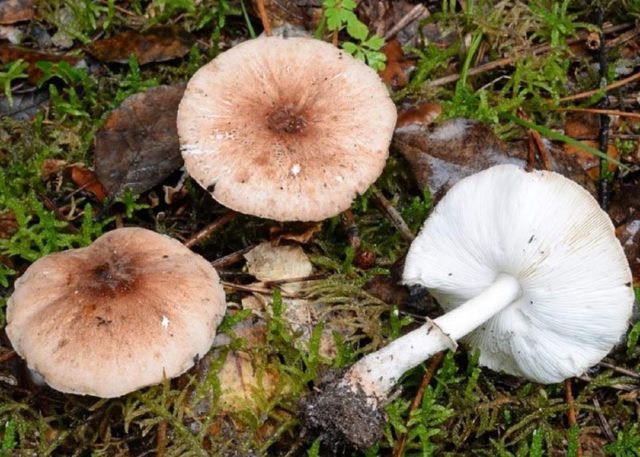
Having studied the main features of the species, you can not be afraid to confuse it with others.
Is it Possible to Eat Pilate's Belonavia
This kind of white champignons is quite rare. Its toxicity is poorly understood, detailed information on the effect on the human body is not available. Because of this, the mushroom is not recommended for consumption. In scientific sources, it is classified as inedible. At the same time, it should be borne in mind that not only can not be eaten, but it is better not to come into contact with fruiting bodies at all. If such a specimen meets on the way of a mushroom picker, you need to bypass it. Also, do not pick it up. This requirement can be explained by the external similarity of the species with other white mushrooms, among which there are edible ones. In order not to be mistaken, you need to carefully study the description and not pick up unfamiliar mushrooms.

The characteristic color of the fruit body helps not to confuse it with edible species
Conclusion
Pilate's Belonavoznik is a rare mushroom and not recommended for harvesting. Knowledge of its main external parameters will help to avoid fruit bodies falling into the basket of lovers of "quiet hunting".
Caring for a nocturnal garden
Growing nocturnal in open soil is quite simple, like most other horticultural crops. Watering should be carried out regularly, while after it and after rain, it is sometimes necessary to loosen the soil surface. After the appearance of weeds, it must be removed immediately, and the bushes are systematically fed. In some cases, due to heavy inflorescences, the stems bend to the surface of the soil, which makes the bushes less attractive. In this case, you will need to install supports, to which the shoots are tied.
Experts advise cutting off the inflorescences immediately after they wither. This culture needs shelter only if a very frosty and little snow winter is expected. The plantings should be covered with non-woven material (lutrasil or spunbond). Spruce paws can also be used to cover the site.
How to water and feed
Watering such flowers is necessary on average 1 time in 7 days, for this they use warm water heated in the sun. During prolonged dry and sultry periods, the frequency of watering should be increased. At the same time, during prolonged rains, watering is suspended, since if the soil is excessively wet all the time, this significantly increases the likelihood that earthen fleas will harm the bushes, since they like to settle on crops belonging to the Cabbage family. It is necessary to water and loosen the soil surface only in the morning.
During the first season, the flowers are regularly fed with a solution of a complex mineral fertilizer, which contains a large amount of nitrogen. In the second year, during the period of bud formation, the plant should be fed with liquid complex fertilizer for flowering plants or phosphorus and potassium fertilizers.
Reproduction of nocturnal
Species and varieties with simple flowers can be propagated by seed. But if terry night violets are cultivated, then they are propagated exclusively by dividing the bush, since if you independently collect seeds from the bushes and sow them, then the grown plants will have simple flowers. The division of bushes of terry varieties is carried out at the beginning of the spring period or in the autumn. To do this, the bush is carefully removed from the ground, divided into several parts, and the cuts are processed with crushed charcoal. Then the delenki are planted in pits, which are prepared in advance.
In late autumn, before the first frosts, the soil surface near the plants must be covered with a layer of mulch, which will save the root system from severe frosts in a winter with little snow.
Nocturnal pests and diseases
The night violet is affected by the same diseases and harmful insects as the rest of the Cruciferous family. Such a flower can be harmed by cabbage aphids, cruciferous fleas and bugs, cauliflower stem moth, cabbage moth, caterpillars of turnip and cabbage whiteflies and cabbage scoops, larvae of rape sawfly and cabbage fly and cruciferous gall midge. Insecticides are used to kill harmful insects; they can be bought at a specialized store. Experts advise to try to find a remedy that effectively destroys pests, while not harming the environment.
During the seedling period, seedlings can get sick with a black leg. An older plant sometimes infects keela, peronosporosis, alternaria, sclerotinia, phomosis, botrytis and fusarium, they are also fungal diseases.Also, the night violet can be struck by such bacterial diseases as black rot and vascular bacteriosis. For this culture, viral diseases such as mosaic and ring spot are very dangerous, since today they are considered incurable. In the fight against fungal diseases, fungicides show high efficiency, the choice of which in specialized stores is quite wide. However, those bushes that are affected by viral or bacterial diseases must be removed from the soil and destroyed as soon as possible. The area where the affected bushes were grown for three or four years will not be suitable for growing a single crop.
However, if you adhere to the rules of prevention and provide the plants with proper care, then they will be highly resistant to both harmful insects and diseases.
Belochampignon long-rooted: where it grows, what it looks like, is it possible to eat, the rules of collection
The genus was first described in 1948 by R. Singer, who placed in it some of the species Lepiota s. l. and attributed it to the tribe Leucocoprinae Singer 1948, which he himself established, together with several morphologically similar genera (Belonavoznik ( Leucocoprinus ), Macrolepiota ( Macrolepiota ), Chlorophyllum ( Chlorophyllum ), Volvolepiota ). Understanding the volume of labor Leucocoprinae there were disagreements between researchers, many species were transferred from one genus to another within this tribe, and sometimes within a family or order. With the advent and development of methods of molecular phylogenetics, the composition of genera is being actively revised. Until 1975, 6-18 species described at that time were attributed to the genus Belochampignon, by 1990 - up to 26 species. According to the 2008 Ainsworth and Bisbee Dictionary of Mushrooms, the genus contains about 90 species.
Description
Description of the genus by morphological characters without taking into account the data of molecular phylogenetics
- Type of development of the fruiting bodypileocarpous.
- The cap is thick, rarely thin fleshy, with or without a tubercle. The surface is often bare, sometimes the skin is cracked and small granular granules or large pressed scales in the center are formed.
- The plates are free, often with colarium, frequent, thin, the edge of the plates is even. The color of young plates is white; with age, they often darken. The tram of the plates is wrong.
- The stem is cylindrical, central, at the base it expands into a tuber or narrows and forms an underground tapered outgrowth. The ring is simple, wide, lagging, motionless.
- Spore powder of whitish or whitish-cream color. Spores are dextrinoid, metachromatic, colorless, or slightly pinkish, creamy, sometimes germinating, ellipsoidal, almond-ellipsoidal or ovoid, up to 10 nm long, smooth, ornamented in some species.
From the kind of Lepiota ( Lepiota ) Belochampignon differs mainly in the habitus of fruit bodies and spores that have a time for germination. Morphologically the closest genera are Belonavoznik and Makrolepiota. The genus differs from the whiteheads by the character of the cap surface and the habitus of the fruiting bodies, from the macrolepiots - by an immobile ring on the stem and the size of the spores.
Ecology
White champignons are found in forests and outside forests, in clearings, forest edges, in fields, parks, steppes, forest belts. Representatives are known both in temperate climates and in the tropics, on all continents except Antarctica.
Practical value
The edibility or toxicity of most species has not been studied. Some species are edible, but due to their rarity or difficulty in pinpointing, they are usually not harvested.
The ruddy white champignon, also known as the nut umbrella, or hazel lepiota, is considered to be of high quality, but it is recommended for picking only by the most experienced mushroom pickers, since this mushroom is easily confused with poisonous ones.
List on the site "Encyclopedia of Life" and other sources:
- Leucoagaricus amanitoides R.M. Davis & Vellinga 2006
- Leucoagaricus americanus (Peck) Vellinga 2000
- Leucoagaricus barssii (Zeller) Vellinga 2000
- Leucoagaricus brunneocingulatus (P.D. Orton) Bon 1976
- Leucoagaricus carneifolius (Gillet) Wasser 1977 - Belochampignon corpuscular
- Leucoagaricus cinerascens (Quél.) Bon & Boiffard 1978
- Leucoagaricus croceovelutinus Bon 1976
- Leucoagaricus crystallifer Vellinga 2000
- Leucoagaricus crystalliferoides T.K.A. Kumar & Manim. 2009
- Leucoagaricus dacrytus Vellinga 2010
- Leucoagaricus georginae (W.G. Sm.) Candusso 1990
- Leucoagaricus glabridiscus (Sundb.) Wuilb. 1986
- Leucoagaricus gongylophorus (Möller) Singer 1986
- Leucoagaricus griseodiscus (Bon) Bon & Migl. 1991
- Leucoagaricus ionidicolor Bellù & Lanzoni 1988
- Leucoagaricus irinellus Chalange 1999
- Leucoagaricus leucothites (Vittad.) Wasser 1977 - Rudened Belochampignon, or Walnut Umbrella
- Leucoagaricus marriagei (D.A. Reid) Bon 1976
- Leucoagaricus medioflavoides Bon 1976
- Leucoagaricus meleagris (Sowerby) Singer 1952
- Leucoagaricus menieri (Sacc.) Singer 1968
- Leucoagaricus moseri Wasser 1978 - Moser Belochampignon
- Leucoagaricus nympharum (Kalchbr.) Bon 1977
- Leucoagaricus pilatianus (Demoulin) Bon & Boiffard 1976
- Leucoagaricus purpureolilacinus Huijsman 1955
- Leucoagaricus serenus (Fr.) Bon & Boiffard 1974
- Leucoagaricus sericifer (Locq.) Vellinga 2000
- Leucoagaricus subcretaceus Bon 1981
- Leucoagaricus sublittoralis (Kühner ex Hora) Singer 1969
- Leucoagaricus tener (P.D. Orton) Bon 1977
- Leucoagaricus viridiflavoides B.P. Akers & Angels 2000
- Leucoagaricus wichanskyi (Pilát) Bon & Boiffard 1974
Species attributed by some authors to the genus Belochampignon and transferred to other genera:
Edibility
Dung beetles include more than 20 types of mushrooms. This representative of the mushroom kingdom belongs to conditionally edible. It is edible while young and the plates are white.
It is not suitable for changing the color of the plates to yellow or pink.
Experienced mushroom pickers boil and fry them. Only hats are good for food.
For drying, they are also not suitable, since in the air they turn into an eerie black mass. Along with harmless species, there are also weakly poisonous ones. When consumed, such specimens will not lead to severe poisoning, but will cause a weak hallucinogenic effect and indigestion.
Common types of dung beetle
dung beetle white
White or shaggy (Coprinus comatus). The most common. It always grows in huge densely standing groups. The cap is ovoid in shape, scattered with scales. There is a brownish tubercle in the center. Bends along the edges to the leg. The plates of young individuals are white, then they turn pink and turn black at one point. Some time after ripening, the cap shrivels, darkens and becomes like a black gruel. The leg is thin and long, thickens towards the base, hollow inside. The white pulp of a young mushroom has a pleasant smell. In some European countries it belongs to delicacies.
dung beetle Gray
Gray or inky. The cap is ovoid, with time it becomes bell-shaped. Gray-brown in color, usually darker in the center, covered with small scales, fibrous is characteristic. In an adult mushroom, cracks appear along the edges. Width 2-5 cm, height 3-7 cm. The pulp is light, but darkens quickly at the break. The leg is hollow in white. It thickens towards the bottom and takes on a yellowish tint. The plates are frequent, free, at the beginning white-gray, then darkened. It got its name since ancient times, when old blackened copies were used instead of ink. It has been proven that gray caprinus contains substances that are incompatible with alcohol-containing beverages. The use of mushrooms and alcoholic beverages leads to poisoning.
Shimmering. Outwardly, it is very similar to a white toadstool. It grows on rotten and old stumps, preferring moist soil. The cap is brown, ovoid, and then bell-shaped, small, only 1-4 cm in diameter. Covered with multiple shiny (or shimmery) scales that are easily washed off with water. The white, thin flesh has a pleasant mushroom smell. The leg is long, thick and hollow, white. There is no ring on it. Spore powder of brown-black color. The plates are frequent, at first white, then darken, turn black and decompose.
Ordinary. The cap is small, only 1-3 cm in diameter. At the beginning of the ripening period - elliptical, with a light felt bloom. In adulthood - bell-shaped, cracked into separate fibers, with remnants of a felt blanket, radially ribbed, with an uneven edge, gray, with a brownish center. In mature fruit bodies, it bends and blackens along the edge, and then begins to decompose. The plates are white, loose, frequent, gray and then black. The stem is cylindrical, has a thickening at the base, is hollow inside, brittle, with a diameter of 0.3 to 0.5 cm, a length of 5-10 cm. The surface is fibrous, with a tapered process, white. Spore powder, black. The pulp is white, then gray, fragile, thin, without a specific smell.
Dyatlovy. They also call the magpie or the motley one.The cap is conical, in mature mushrooms it is broadly bell-shaped, 5-10 cm in diameter. Almost all young fruiting bodies are covered with a white felt blanket. As it develops, the bedspread breaks and only large white flakes remain. The surface of the cap is brown, yellow or black-brown. In mature mushrooms, the edges sometimes bend to the top, and then blur along with the plates. The plates are convex, frequent, free. First white, then pink, ocher-gray, eventually black. The pulp is white, thin, sometimes brownish. The stem is thin, cylindrical, slightly tapering towards the cap, 0.5-1.5 cm thick, 10-30 cm high, with a slight tuberous thickening, fragile. The surface is white, smooth, but sometimes flaky. The taste and smell are not expressed.
Woodpecker dung
Synonyms: Coprinus picaceus
Specifications:
- Group: lamellar
- Records: loose

